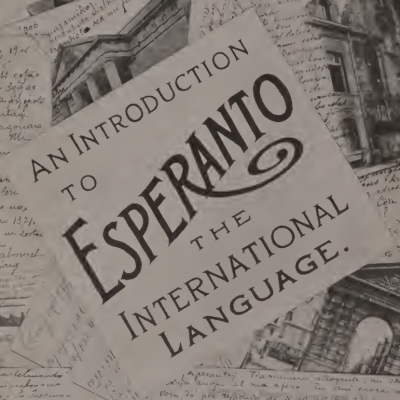About Esperanto & Internationalism c.1880-1920s

Welcome to our collaborative project “Esperanto and Internationalism, c. 1880s-1920”.
Esperanto was created by the Polish-Jewish doctor, Ludwik Lejzer Zamenhof (1859-1917). He grew up in Bialystok (today’s Poland) in Tsarist Russia. In the 1870s in Bialystok, with a large Jewish population, one would have heard Polish, Russian, Yiddish, Hebrew along with another handful of languages and dialects. As a young medical student in Warsaw the young Zamenhof witnessed the anti-Jewish pogroms in 1882/83 that raged across the region. It was against this backdrop of rising ethno-nationalist tensions, at a time of globalisation, internationalism, and nationalism, that Zamenhof published his first two Esperanto manuals, Unua Libro and Dua Libro in 1887/88, first in Russian, and swiftly translated into other languages. English was not yet the globally dominant language around 1900. Esperanto sought to fill that void and to end the “Babelization” of languages. With Esperanto, Zamenhof and his many followers hoped (Esperanto translates as “the one who hopes”) to give the world a neutral, non-national communication ground for a better, peaceful future of mankind.
The Esperanto movement or community bridged generations, it brought together women and men, it attracted Jews, Catholics, Protestants, and Freethinkers. It attracted teachers, scientists, engineers, doctors, later on workers and civil servants. The Esperanto pulled in numerous female activists, some of whom were leading scientists of the day and pioneers in the women’s movement and peace movement of the time.
While research on Esperanto exists, the movement as such has hardly been studied as what it truly was: a cross-border, translocal, and transregional, and in fact global community. While all projects follow discrete questions and local and national particularities, they follow an explicit transnational perspective: a spatial and scalar perspective that starts from the local and individual and building outwards from there to the regional, national, and transnational level. The project builds on a complex linguistic and far-spread archival base from local and private archives, to city archives, museums, and national archives. It has a spatial and Digital History component by data mining of sources and visualisation of local memberships, journal publications, and international congress participation.
We would like to thank a number of sponsors of the project: the University of St Andrews, the University of Bonn, the German Academic Exchange Service (DAAD), the Fritz Thyssen Foundation, the CEDIES (Luxembourg), ESF (Esperantic Studies Foundation), the Leverhulme Trust.

